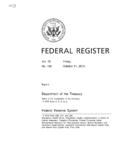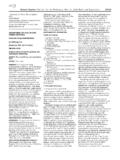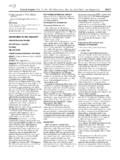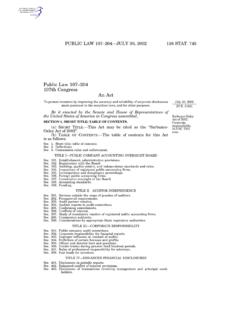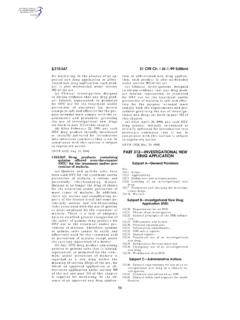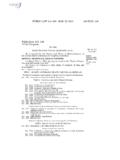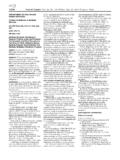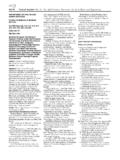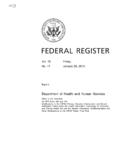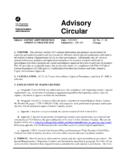Transcription of Department of Transportation
1 Friday, May 28, 2010 Part III Department of Transportation federal aviation administration 14 CFR Part 91 Automatic Dependent Surveillance Broadcast (ADS B) Out Performance Requirements To Support Air Traffic Control (ATC) Service; Final Rule VerDate Mar<15>2010 18:17 May 27, 2010 Jkt 220001 PO 00000 Frm 00001 Fmt 4717 Sfmt 4717 E:\FR\FM\ 28 MYR3mstockstill on DSKH9S0YB1 PROD with RULES330160 federal Register/ Vol. 75, No. 103 / Friday, May 28, 2010 / Rules and Regulations Department OF Transportation federal aviation administration 14 CFR Part 91 [Docket No.]
2 FAA 2007 29305; Amdt. No. 91 314] RIN 2120 AI92 Automatic Dependent Surveillance Broadcast (ADS B) Out Performance Requirements To Support Air Traffic Control (ATC) Service AGENCY: federal aviation administration (FAA), DOT. ACTION: Final rule. SUMMARY: This final rule amends FAA regulations by adding equipage requirements and performance standards for Automatic Dependent Surveillance Broadcast (ADS B) Out avionics on aircraft operating in Classes A, B, and C airspace, as well as certain other specified classes of airspace within the National Airspace System (NAS).
3 ADS B Out broadcasts information about an aircraft through an onboard transmitter to a ground receiver. Use of ADS B Out will move air traffic control from a radar-based system to a satellite-derived aircraft location system. This action facilitates the use of ADS B for aircraft surveillance by FAA and Department of Defense (DOD) air traffic controllers to safely and efficiently accommodate aircraft operations and the expected increase in demand for air Transportation . This rule also provides aircraft operators with a platform for additional flight applications and services.
4 DATES: This final rule is effective on August 11, 2010. The compliance date for this final rule is January 1, 2020. Affected parties, however, do not have to comply with the information collection requirement in until the FAA publishes in the federal Register the control number assigned by the Office of Management and Budget (OMB) for this information collection requirement. Publication of the control number notifies the public that OMB has approved this information collection requirement under the Paperwork Reduction Act of 1995.
5 The incorporation by reference of certain publications listed in the rule is approved by the Director of the federal Register as of August 11, 2010. FOR FURTHER INFORMATION CONTACT: For technical questions concerning this final rule, contact Vincent Capezzuto, Surveillance and Broadcast Services, AJE 6, Air Traffic Organization, federal aviation administration , 800 Independence Avenue, SW., Washington, DC 20591; telephone (202) 385 8637; e-mail For legal questions concerning this final rule, contact Lorelei Peter, Office of the Chief Counsel, AGC 220, federal aviation administration , 800 Independence Avenue, SW.
6 , Washington, DC 20591; telephone 202 267 3134; e-mail SUPPLEMENTARY INFORMATION: Authority for This Rulemaking The FAA s authority to issue rules on aviation safety is found in Title 49 of the United States Code (49 ). Subtitle I, Section 106, describes the authority of the FAA Administrator. Subtitle VII, aviation Programs, describes in more detail the scope of the agency s authority. This rulemaking is promulgated under the authority described in Subtitle VII, Part A, Subpart I, Section 40103, Sovereignty and use of airspace, and Subpart III, Section 44701, General requirements.
7 Under section 40103, the FAA is charged with prescribing regulations on the flight of aircraft (including regulations on safe altitudes) for navigating, protecting, and identifying aircraft, and the efficient use of the navigable airspace. Under section 44701, the FAA is charged with promoting safe flight of civil aircraft in air commerce by prescribing regulations for practices, methods, and procedures the Administrator finds necessary for safety in air commerce. This regulation is within the scope of sections 40103 and 44701 because it prescribes aircraft performance requirements to meet advanced surveillance needs to accommodate increases in NAS operations.
8 As more aircraft operate within the airspace, improved surveillance performance is necessary to continue to balance the growth in air Transportation with the agency s mandate for a safe and efficient air Transportation system. Guide to Terms and Acronyms Frequently Used in This Document ACI NA Airports Council International- North America ACSS aviation Communication and Surveillance Systems ADIZ Air Defense Identification Zone ADS B Automatic Dependent Surveillance- Broadcast ADS C Automatic Dependent Surveillance- Contract ADS R Automatic Dependent Surveillance- Rebroadcast AGL Above Ground Level AIA Aerospace Industries Association of America ALPA Air Line Pilots Association.
9 International AOPA Aircraft Owners and Pilots Association ARC aviation Rulemaking Committee ASA Aircraft Surveillance Applications ASAS Aircraft Surveillance Applications System ASDE X Airport Surface Detection Equipment, Model X ASSA Airport Surface Situational Awareness ATC Air Traffic Control CAA Cargo Airline Association CDTI Cockpit Display of Traffic Information CNS Communication, Navigation, and Surveillance EAA Experimental Aircraft Association ELT Emergency Locator Transmitter ES Extended Squitter EUROCAE European Organisation for Civil aviation Equipment EUROCONTROL European Organisation for the Safety of Air Navigation FAROA Final Approach Runway Occupancy Awareness FedEx federal Express FIS B Flight Information Service Broadcast FL Flight Level GA General aviation GAMA General aviation Manufacturers Association GNSS Global Navigation Satellite System GPS Global Positioning System HAI Helicopter
10 Association International IATA International Air Transport Association ICAO International Civil aviation Organization MHz Megahertz MOPS Minimum Operational Performance Standards MSL Mean Sea Level NACP Navigation Accuracy Category For Position NACV Navigation Accuracy Category for Velocity NAS National Airspace System NBAA National Business aviation Association NextGen Next Generation Air Transportation System NIC Navigation Integrity Category NM Nautical Mile NPRM Notice of Proposed Rulemaking NTSB National Transportation Safety Board OPD Optimized Profile Descent OMB Office of Management and Budget RAA Regional Airline Association RAIM Receiver Autonomous Integrity Monitoring RFA Regulatory Flexibility Act RNP Required Navigation Performance SANDIA Sandia National Laboratories SARPs Standards and Recommended Practices SCAP Security Certification and Accreditation Procedures SDA System Design Assurance SIL Source Integrity Level SSR Secondary Surveillance Radar TCAS Traffic Alert and Collision and Avoidance System

